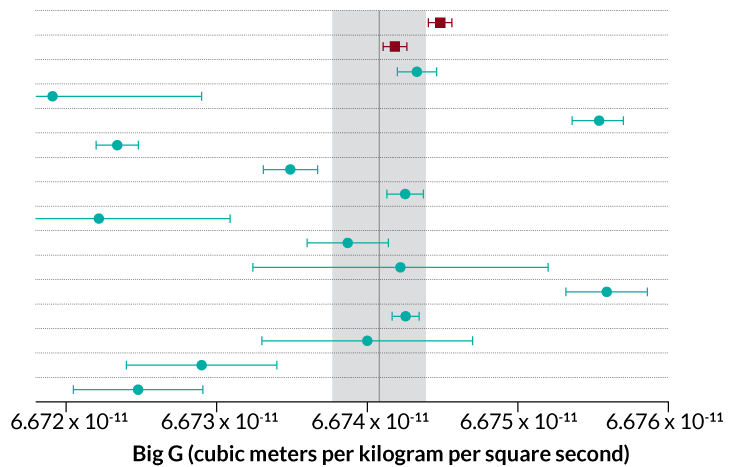In General
> s.a. newtonian gravitation; theories of gravity.
* History of measurements: 1687, Newton guessed
its value to within 2%; 1798, Cavendish and Michell measured it to within 1%; 1895, C V Boys at
Clarendon Laboratory measured it to within 0.1%; 2000, Measurements by Gundlach & Merkowitz
of the Eöt-Wash Group with 10−5 relative error.
* Value: G
= 6.67390 × 10−11
N·m2/kg2
± 0.0014% (2000 value, from torsional balance experiment at the University of Washington);
* 2001: G =
6.67559 × 10−11
N·m2/kg2
± 41 ppm (BIPM-Birmingham team of Terry Quinn et al);
* 2004: G
= (6.675 ± 0.007) × 10−11
N·m2/kg2
(using a superconducting gravimeter, Bologna);
* 2005: G
= 6.6723(9) × 10−11
N·m 2/kg2
in the HUST experiment;
* 2006: G
= 6.674252(109)(54) × 10−11
N·m2/kg2,
with beam balance;
* 2008: CODATA value (6.67428
± 0.00067) × 10−11
N·m2/kg2;
* 2009:
G = 6.67349(18) × 10−11
N·m2/kg2
with time-of-swing method;
* 2010:
G = 6.67234(14) × 10−11
N·m2/kg2
from the change in spacing between two free-hanging pendulum masses;
* 2013:
G = 6.67545(18) × 10−11
N·m2/kg2 from
new International Bureau of Weights and Measures (BIPM) measurements using two methods.
* 2014: Serious disagreement between different
measurements of G is a sign of problems with the theory and/or experiments.
* 2018: New experiments give the
smallest uncertainty yet, G = 6.674184 (11.64 ppm) and 6.674484 (11.61 ppm)
× 10−11
N·m2/kg2.
* Status: It is difficult to measure because
in the lab gravity is weak, and in astronomy it appears in the combination GM; The
best values come from modern versions of the Cavendish experiment, although some geophysical
data seem to contradict them.
@ General references: de Sabbata et al ed-04;
Wilczek PT(01)jun [smallness].
@ Status of measurements:
Milyukov et al G&C(08);
Milyukov & Fan G&C(12);
Horstman & Trimble a1811 [history, 1686 to 2016].
@ And the dilaton: Zee PRL(79);
Nieh PLA(82);
> s.a. conformal invariance.
@ Other origin:
Townsend PRD(77) [spacetime structure];
Damour MST(99)gq [significance];
> s.a. emergent gravity [entropic].
> Online resources:
see Wikipedia page.
Measurements
* Methods: In the lab, it
can be measured with a torsion balance, in static/compensation mode or in
dynamic mode, or with an electronic balance.
@ General references: Anderson et al EPL(15)-a1504 [correlation of results with the length of the day];
news sn(15)apr [discrepancy not understood].
@ Torsion balance: Kuroda PRL(95);
Gundlach et al PRD(96);
Luo et al PRD(99) [torsion pendulum period];
Gundlach & Merkowitz PRL(00)gq;
Schwarzschild PT(00)jul;
Quinn et al PRL(01);
Armstrong & Fitzgerald PRL(03);
Fitch et al AJP(07)apr [automation];
Kuznetsov et al G&C(07);
Luo et al PRL(09),
Tu et al PRD(10) [time-of-swing method];
Quinn et al PRL(13).
@ Space-based: Sanders & Gillies RNC(96);
Alexeev et al G&C(99)gq/00,
Metr-gq/01,
Melnikov gq/00 [SEE];
Swain a1405 [using a purely gravitational oscillator];
Feldman et al CQG(16)-a1605
+ CQG+ [proposal].
@ Other measurements: Gillies Met(87) [index];
Hubler et al PRD(95) [lake];
Schurr et al PLA(98),
PRL(98),
Schlamminger et al PRL(02),
PRD(06) [beam balance];
Baldi et al PRD(05) [superconducting gravimeter];
Lamporesi et al PRL(08) [cold-atom interferometry];
Parks & Faller PRL(10) [simple-pendulum experiment];
Pitkin EPL(15)-a1505 [on correlation with observed periodic variations in the length of the day];
Armata et al PRA(17)-a1707 [using an optomechanical cavity];
Li et al Nat(18)aug
+ news sn(18)sug [using two independent methods];
Kawasaki a1903 [precision displacement sensors].

Measured values of the gravitational constant. Credit: S Schlamminger / Nature 2018
Running / Scale Dependence in Quantum Theory
> s.a. asymptotic safety; dark
matter [alternative]; renormalization of quantum gravity.
* Idea: 2005, Some
non-perturbative studies of quantum gravity suggest that the effective
G might slowly increase with distance; In cosmology, this may work
as an alternative to dark matter and be related to the expansion acceleration.
@ General references: Greensite PRD(94)gq/93 [in quantum gravity, universe not in an eigenstate of G];
Dou & Percacci CQG(98)ht/97;
Reuter ht/00;
Hamber & Williams PRD(05)ht [vacuum polarization, effective field equations],
PRD(07)ht/06 [static isotropic];
López Nacir & Mazzitelli PRD(07)ht/06 [and non-integer powers of \(\square\)];
Robbers et al PRL(08);
Calmet et al PRD(08)-a0803 [without extra dimensions];
Jalalzadeh & Darabi IJMPA(10)-a1010 [one-loop correction in FLRW models];
Anber & Donoghue PRD(12)-a1111 [no useful and universal definition];
Nagy et al JHEP(12)-a1203 [infrared fixed point];
Frampton & Karl a1304 [at very short distances];
Codello et al PRD(14)-a1304 [consistent closure of RG flow];
Falls PRD(15)-a1501 [gauge-independent beta function];
Solodukhin PRD(15)-a1502 [due to fields of various spins];
Moffat a1505 [modified gravitational theory];
Smolin CQG(16)-a1507 [G and Λ as conjugate dynamical variables];
Chen et al a2008 [quantum corrections];
> s.a. unimodular gravity.
@ And observations / phenomenology:
Reuter & Weyer JCAP(04),
EAS(06)ap/05-proc [astrophysical distances];
Reeb a0901-proc [and standard model, GUTs];
Rodrigues et al PoS-a1301 [inside galaxies];
Moffat a1507 [in astrophysics and cosmology].
Other Issues and Generalizations
> s.a. variation of newton's gravitational constant.
@ References: Deffayet & Woodard JCAP(09) [distorted constant, and cosmology].
main page
– abbreviations
– journals – comments
– other sites – acknowledgements
send feedback and suggestions to bombelli at olemiss.edu – modified 13 may 2021